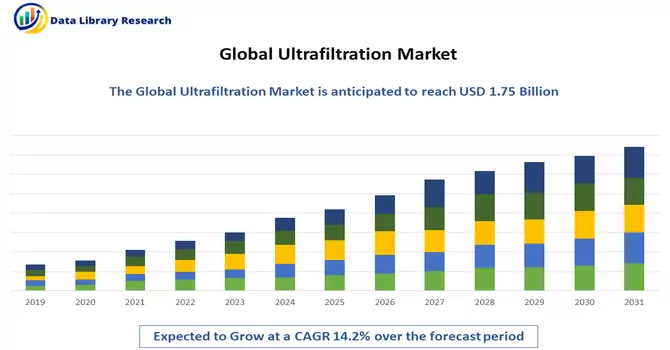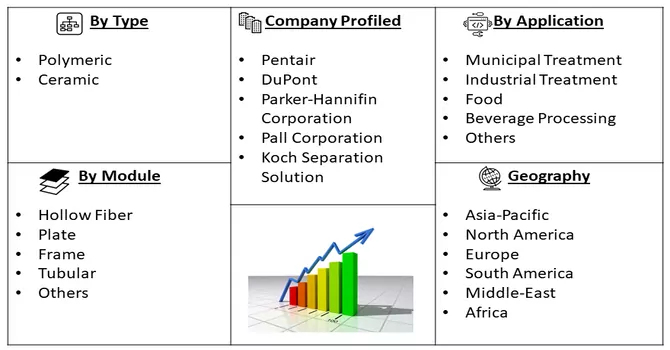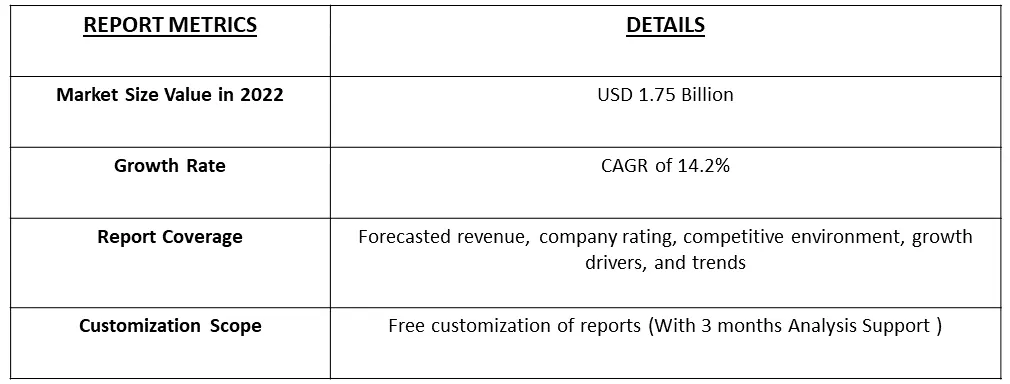The ultrafiltration market size was USD 1.75 Billion in 2022, and is expected to register a revenue CAGR of 14.2% during the forecast period, 2023-2030.

Get Complete Analysis Of The Report - Download Free Sample PDF
Ultrafiltration (UF) is a water purification process in which water is forced through a semipermeable membrane. Suspended solids and high-molecular-weight solutes remain on one side of the membrane, the retentate side, while water and low-molecular-weight solutes filter through the membrane to the permeate side.
The rapid growth rate in population and industries worldwide is rising demand for wastewater treatment facilities, which is driving revenue growth of the ultrafiltration market.
The rising concerns over water scarcity and the need for sustainable water treatment solutions have driven the adoption of ultrafiltration in municipal and industrial wastewater treatment. The biopharmaceutical industry's growth has created a demand for ultrafiltration in downstream processing, protein purification, and drug formulation. Moreover, the ongoing research and development efforts have led to the development of advanced membrane materials and module designs, enhancing the efficiency and cost-effectiveness of ultrafiltration systems and thus the market is expected to witness significant growth over the forecast period.
Segmentation:
The Ultrafiltration Market is Segmented
By Type :
Module :
Application :
Geography :
The market sizes and forecasts are provided in terms of value (USD million) for all the above segments.

For Detailed Market Segmentation - Download Free Sample PDF
Drivers:
Rise in Awareness Regarding Water and Wastewater Treatment
The growing awareness of water and wastewater treatment, with a special focus on ultrafiltration, is a positive step toward addressing crucial global challenges related to clean water access and environmental sustainability. Moreover, governments, non-profit organizations, and educational institutions are working hard to share information about the benefits of ultrafiltration and responsible water management. Through campaigns, seminars, and workshops, both professionals and the general public are gaining a better understanding of the significance of water and wastewater treatment.
Stringent Regulations Regarding Sustainable Policies Concerning the Environment
The stringent regulations concerning sustainable policies concerning the environment, and the National Environmental Policy Act of 1969 (NEPA) force government agencies to analyze the environmental effects of major federal actions that are likely to have a significant impact on the environment. The OECD has been developing proxies of environmental policy stringency (EPS) based on the measurement of stringency defined as the implicit or explicit cost of environmentally harmful behavior. Environmental laws in India are adopted, implemented, and enforced by three main entities: the Ministry of Environment, Forest, and Climate Change along with the Central Pollution Control Board at the National level as well as the State Pollution Control Boards at the State level. Thus, due to these laws, the demand for ultrafiltration is significantly increased thereby driving the growth of the studied market.
Restraints:
High Cost of Ultrafiltration and Maintenance
The capital costs associated with installing ultrafiltration systems can be a barrier for smaller companies and regions with limited resources. Also, regular maintenance and membrane replacement can be expensive, affecting the total cost of ownership. Moreover, the lack of awareness about the benefits and applications of ultrafiltration in certain regions and industries can impede market growth.
The global ultrafiltration market experienced a setback during the COVID-19 pandemic but has since made a significant recovery. In 2020, demand for ultrafiltration systems was low as the global lockdown temporarily halted industrial activities. However, with the reopening of industries in 2021, the generation of wastewater resumed, leading to an increased demand for ultrafiltration systems. Moreover, wastewater treatment and ultrafiltration (UF) systems are finding growing adoption in drinking water production facilities to filter out harmful biological pathogens, including the SARS-CoV-2 virus responsible for COVID-19. UF membranes, with pore sizes ranging from 0.01µm to 0.1µm, are effective at trapping viral particles, ensuring the production of clean and safe potable water as the filtrate. There is also a rising demand for home water purification systems that incorporate ultrafiltration candles. This demand is being driven by increased consumer awareness regarding the adverse effects of COVID-19 and the need for clean and safe drinking water. Thus, the global ultrafiltration market faced challenges during the pandemic but has rebounded as industrial activities resumed. The use of UF systems has expanded to include viral pathogen removal, and consumers are increasingly adopting home water purification systems to safeguard against waterborne contaminants, including those related to COVID-19.
Segmental Analysis:
The Polymeric Segment is Expected to Witness Significant Growth Over the Forecast Period
Polymeric membranes are expected to experience a significant revenue growth rate during the forecast period due to their widespread availability and cost-effectiveness compared to other ultrafiltration methods. These membranes are also suitable for various applications such as municipal and industrial treatment applications. Various organic and synthetic polymers are significant materials for separating gases and removing organic and inorganic contaminants from wastewater. A variety of nanomaterials are available for modifying polymeric membranes. Thus, the segment is expected to witness significant growth over the forecast period.
Tubular Segment is Expected to Witness Significant Growth Over the Forecast Period
Tubular ultrafiltration is a versatile and efficient membrane-based filtration technology that finds applications in various industries, from water treatment and food processing to pharmaceuticals and biotechnology. Tubular ultrafiltration employs a tubular membrane, which is a porous barrier with precise pore sizes typically ranging from 0.001 to 0.1 micrometers. This allows the filtration process to separate particles, macromolecules, and microorganisms from a fluid or solution. Thus, the segment is expected to witness significant growth for the forecast period.
Pharmaceutical Processing Segment is Expected to Witness Significant Growth Over the Forecast Period
Ultrafiltration plays a critical role in pharmaceutical processing, particularly in downstream bioprocessing and the purification of biopharmaceutical products. This method utilizes semi-permeable membranes to separate and purify biomolecules and other substances based on their size and molecular weight. Thus, the segment is expected to witness significant growth over the forecast period.
North America is Expected to Witness Significant Growth Over the Forecast Period
North America has seen significant developments and applications of ultrafiltration technology across various industries. Ultrafiltration is a versatile separation process that uses a semipermeable membrane to remove suspended solids, macromolecules, and other impurities from liquids. Many industrial facilities in North America use ultrafiltration for treating and recycling wastewater. It enables the removal of pollutants, chemicals, and suspended solids from industrial effluents, making it an environmentally friendly and cost-effective solution for meeting regulatory requirements. Thus, the region is expected to witness significant growth over the forecast period.

Get Complete Analysis Of The Report - Download Free Sample PDF
Some of the major players working in this segment are:
Recent Development:
1) In June 2020, Microdyn-Nadir introduced a new brand for their hollow fiber Polyvinylidene Fluoride (PVDF) ultrafiltration product line. Surface water, groundwater, seawater, and tertiary processed effluent are all treated with the modules.
2) In December 2021, Dupont announced its partnership with Water.org in order to increase access to safe water on a global level. This collaboration is also focusing on vulnerable communities that lack a regular supply of potable water. This project is expected to leverage the water filtration capabilities of the former company along with the purification technologies of the latter.
Q1. How big is the Ultrafiltration Market?
The ultrafiltration market size was USD 1.75 Billion in 2022, and is expected to register a revenue CAGR of 14.2% during the forecast period, 2023-2030.
Q2. At what CAGR is the market projected to grow within the forecast period?
Ultrafiltration Market is expected to register a revenue CAGR of 14.2% during the forecast period.
Q3. Who are the key players in Ultrafiltration Market?
Some key players operating in the market include Pentair, DuPont, Parker-Hannifin Corporation and Pall Corporation.
Q4. What segments are covered in the Ultrafiltration Market Report?
By Type, Module, Application and Geography are the segments covered in the Ultrafiltration Market Report.
Data Library Research are conducted by industry experts who offer insight on industry structure, market segmentations technology assessment and competitive landscape (CL), and penetration, as well as on emerging trends. Their analysis is based on primary interviews (~ 80%) and secondary research (~ 20%) as well as years of professional expertise in their respective industries. Adding to this, by analysing historical trends and current market positions, our analysts predict where the market will be headed for the next five years. Furthermore, the varying trends of segment & categories geographically presented are also studied and the estimated based on the primary & secondary research.
In this particular report from the supply side Data Library Research has conducted primary surveys (interviews) with the key level executives (VP, CEO’s, Marketing Director, Business Development Manager and SOFT) of the companies that active & prominent as well as the midsized organization
FIGURE 1: DLR RESEARH PROCESS

Extensive primary research was conducted to gain a deeper insight of the market and industry performance. The analysis is based on both primary and secondary research as well as years of professional expertise in the respective industries.
In addition to analysing current and historical trends, our analysts predict where the market is headed over the next five years.
It varies by segment for these categories geographically presented in the list of market tables. Speaking about this particular report we have conducted primary surveys (interviews) with the key level executives (VP, CEO’s, Marketing Director, Business Development Manager and many more) of the major players active in the market.
Secondary ResearchSecondary research was mainly used to collect and identify information useful for the extensive, technical, market-oriented, and Friend’s study of the Global Extra Neutral Alcohol. It was also used to obtain key information about major players, market classification and segmentation according to the industry trends, geographical markets, and developments related to the market and technology perspectives. For this study, analysts have gathered information from various credible sources, such as annual reports, sec filings, journals, white papers, SOFT presentations, and company web sites.
Market Size EstimationBoth, top-down and bottom-up approaches were used to estimate and validate the size of the Global market and to estimate the size of various other dependent submarkets in the overall Extra Neutral Alcohol. The key players in the market were identified through secondary research and their market contributions in the respective geographies were determined through primary and secondary research.
Forecast Model
